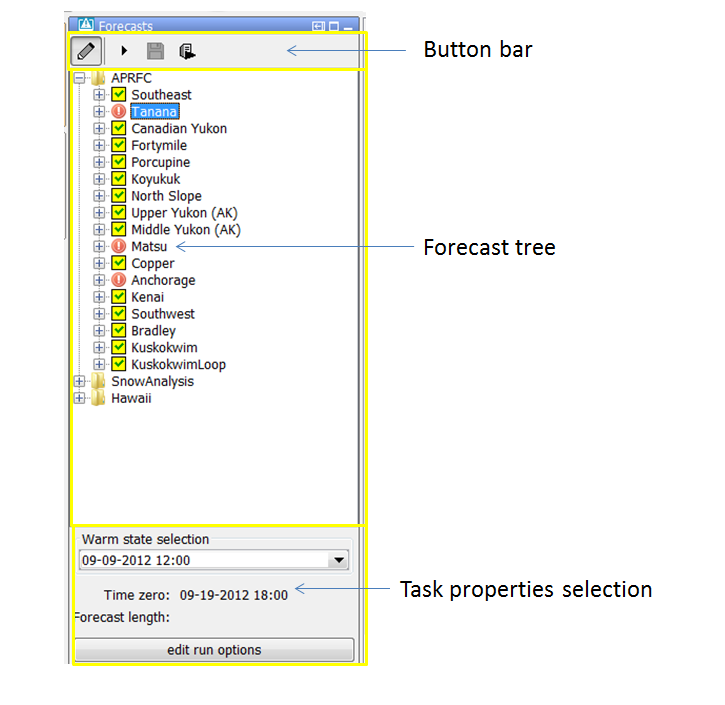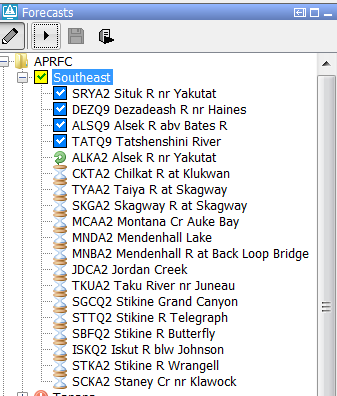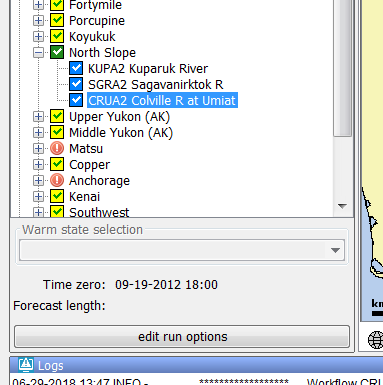...
The IFD (Interactive Forecasting Displays) consists of several panels. Each of these panels has a specific role in the process of creating a forecast with the IFD. In this chapter the functionality of each panel in the IFD will be explained.
In chapter How to create a forecast with the IFD will be explained with a use case how a forecast can be created with the IFD by using the combined functionality of the separate panels.
Forecast panel
The forecast panel (indicated in yellow rectangle above) plays a central role in creating a forecast in the IFD. The The forecast panel shows a tree with all the forecast points for a region and a logical grouping of these forecast points.
It is also possible to show the work process of a forecaster in the forecast panel. The forecast panel consists of three main sections each of them will be explained in detail in the coming sections.
Button bar
The top of the forecast panel shows a button bar. By default this button bar will look like this.
...
| Icon | Action | Visible | Enabled | Available since |
|---|---|---|---|---|
| Switches to IFD between read-only mode and edit-mode | when the option <enableAutoRun> is set to true. | always | ||
| Starts the workflow of the node in IFD-mode. | always |
| ||
| promotes a local IFD run to a server run. | always | when the node has an IFD-run and when the option <saveLocalRunEnabled> is set to true. | ||
| starts a workflow in server mode. | always |
| ||
| starts the secondary workflow of the selected node | when any node has a secondary workflow configured. | when a node is selected which has a secondary workflow configured. | 2018.01 | |
If the button is selected the threshold icons will be shown instead of the regular run status icons | always | always | 2019.02 | |
| If this button is selected a modifier icon will be shown for a topology node if active modifiers are visible in the modifiers panel if that topology node is selected. This means that if you disable for a topology node that modifiers are visible in the modifiers panel that the modifier icon will also not be visible. | Visible by default, unless the option <hideModifiersButton> is set to true | always | 2020.01 |
Original button bar (6 buttons)
Alternatively, your Delft-FEWS application can show the original button bar with 6 buttons
| Icon | Action | Visible | Enabled | Available since |
|---|---|---|---|---|
| Switches to IFD between read-only mode and edit-mode | when the option <enableAutoRun> is set to true. | always | ||
| step to the next leaf node in the topology tree | always | always | ||
| start a workflow in IFD mode | always | when a node is selected for the option <localRun> is set to true | ||
| start all the workflows of the children of the group node in IFD-mode | always | when a group node is selected | ||
| starts a workflow in server mode. | always |
| ||
updates the system time to the current time. | always | always | ||
| starts the secondary workflow of the selected node | when any node has a secondary workflow configured. | when a node is selected which has a secondary workflow configured. | 2018.01 | |
| If this button is selected a modifier icon will be shown for a topology node if active modifiers are visible in the modifiers panel if that topology node is selected. This means that if you disable for a topology node that modifiers are visible in the modifiers panel that the modifier icon will also not be visible. | Visible by default, unless the option <hideModifiersButton> is set to true | always | 2020.01 |
Forecast tree and icons
The forecast tree is shown in the middle section of the forecast panel.The The tree consists of two types of nodes:
...
The status of the workflow of the workflow nodes is indicated by an icon. The The icon can indicate the following statuses:
- Running,
- Pending,
- Failed,
- SuccesfullSuccessful
- Succesfull Successful but the time zero of the run is different then the time zero of the IFD,
- Succesfull Successful but the workflow needs to be rerun because the state selection was changed, a modifier was created after the run or the forecast length is changed,
- A combination of the 2 statuses above.
Below an overview of all the combinations which are available for a succesfull successful run (local or server).
Running
A workflow which is running locally or at the server will be indicated by a curved arrow icon.
In the example below the workflow of the node ALKA2 is running.
Pending
A workflow that is pending to run is indicated by an hourglass . In the example above all the nodes below ALKA2 are pending.Succesfull
Successful run
If a workflow was fully succesfull successful the node will have a blue or for a local run, and green icon .
A local succesfull run will be indicated by a blue icon a succesfull server run will be indicated by a green icon .
In the example below a server run has run succesfully for a server run.
The example below shows a successful server run for node North Slope. For the leaf nodes KUPA2, SGRA2 and CRUA2 a successfull IFD successful local run was executed.
Successful run
Successful run with a different time zero
If the time zero of a node is different than the time zero which was used in the successful run then the icons will be different.are grey instead of green and blue and the check marks are now blue and green.
The example below shows a screenshot of the same Delft-FEWS system as shown above but now with a different time zero.
The icons are grey instead of green and blue and the check marks are now blue and green.
Failed run
A failed run is indicated by an icon with a exclamation mark . If the time zero of the failed run is equal to the time zero of the node the exclamation mark will be red otherwise it will be black.
In the example below the node Matsu has a failed run with a time zero equal to the time zero of the IFD (09-19-2012). When time zero changes (because the system time was changed) the icons also change. The red exclamation marks are changed to black.
...
When a modifier is made at a node with a local successful run then the icon will change to a yellow icon with a blue check (local run) or yellow icon with a green check (server run)to indicate that the workflow of that node needs to rerun.
In the example below a modifier was made to the node KUPA2.
...
If the user changes the state selection in the IFD so that the state selection used in the run doesn't match the state selection in the IFD anymore then the icon will turn to a yellow icon with a blue check (local run) or yellow icon with a green check (server run)to indicate that the node needs to be rerun.An An example is shown below
Forecast length
...
The results of a node can only be valid if all the previous nodes have run successfully prior to the run of a node and when all the previous nodes have valid status.
In the example below node TUNA2 has a successfull status. When the user reruns the previous node NEBA2 then node TUNA2 also needs to rerun to make sure that its results are up-to-date.To To indicate this the icon of node TUNA2 is changed to a yellow icon with a blue check (local run) .
...
The bottom section of the forecast panel can be used to select the task properties of a node.
The following properties can be changed or set:
...
The majority of these settings can be adjusted in the bottom section of the panel .
(left screenshot). More options are available in the panel which can be started by clicking on the "edit run options" button (right screenshot).
The initial state selection, time zero and forecast length which are set directly after selecting a node can be determined by the configuration. In the following section The page 24 Topology is described describes which configuration options are available.
Modifiers panel
The modifiers panel is an important display in the IFD. It shows the modifiers which are created for the selected node in the forecast panel or (since 2019.02) the modifiers for the grid plot on which spatial modifier mode has been activated. Modifiers can be created, modified or deleted in this panel.
The upper part of the display gives an overview of the modifiers created for the currently selected node in the forecaster panel. When a modifier is selected in this panel, the details will be shown in the lower part of the panel. It also allows the user to make mods active and inactive with the checkbox in the column Active. When a modifier is made locally, it get's a salmon background color. When it is saved to the server (by running the associated WF on the server), it gets a green background color.
The position of the splitter between the table and the editor is stored in user_settings.ini. When Fews is closed and then launched again, the splitter appears at the previously set position.
...
- Delete - A modifier can be deleted by pressing the cross icon. If you have made a local change to a saved modifier, only the local change will be deleted when you press the cross. The background color will change back from salmon to green. If you delete it again, the saved modifier will be deleted as well. (Note, in a SA the behavior is different. In a SA a single delete action deletes the entire modifier.) If you make use of the Run Info panel (see Explorer Tasks, with <taskClass>nl.wldelft.fews.gui.plugin.runinfo.RunInfoPanel</taskClass>), this will show both the saved and local modifiers, so you can compare them directly.
...
- Copy - The copy-icon copies the modifier.
Splitter - The position of the splitter between the table and the editor is stored in user_settings.ini. When the application is reopened, the splitter appears at the previously set position.
Spatial display
Since 2019.02, there are modifier types which are used to modify grid time series. These spatial modifiers need to be created through the spatial display instead of the modifiers panel. More information on how to create spatial modifiers in the spatial display is found at User Guide > 05 Spatial Display > Creating Spatial Modifiers.
...
| Icon | Action | Visible | Enabled | Available since |
|---|---|---|---|---|
| Switches to IFD between read-only mode and edit-mode | when the option <enableAutoRun> is set to true. | always | ||
| step to the next leaf node in the topology tree | always | always | ||
| start a workflow in IFD mode | always | when a node is selected for the option <localRun> is set to true | ||
| start all the workflows of the children of the group node in IFD-mode | always | when a group node is selected | ||
| starts a workflow in server mode. | always |
| ||
updates the system time to the current time. | always | always | ||
| starts the secondary workflow of the selected node | when any node has a secondary workflow configured. | when a node is selected which has a secondary workflow configured. | 2018.01 | |
| If this button is selected a modifier icon will be shown for a topology node if active modifiers are visible in the modifiers panel if that topology node is selected. This means that if you disable for a topology node that modifiers are visible in the modifiers panel that the modifier icon will also not be visible. | Visible by default, unless the option <hideModifiersButton> is set to true | always | 2020.01 |
Forecast tree
The forecast tree is shown in the middle section of the forecast panel.
...



























